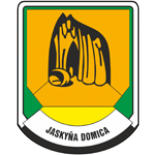
Domica Cave is the most known and longest cave of the Slovak Karst National Park. Except for important geomorphological features, it is interesting by precious archaeological findings, occurrence of flowstone shields and drums, as well as numerous bat species presence. The cave belongs in the world heritage site „The Caves of Slovak and Aggtelek Karst“.
| mon | tue | wed | thu | fri | sat | sun |
| 1 | 2 | 3 | 4 | 5 | 6 | |
| 7 | 8 | 9 | 10 | 11 | 12 | 13 |
| 14 | 15 | 16 | 17 | 18 | 19 | 20 |
| 21 | 22 | 23 | 24 | 25 | 26 | 27 |
| 28 | 29 | 30 |
Domica Cave - Short tour
9:30, 11:00, 12:30, 14:00
| Cave tour | Adults |
Children 6-15y., handicapped people *1 |
Students, > 60 years *2 |
Photo-Video without using a tripod *3 |
Extra admission *4 |
| Domica Cave - Short tour *5 | 10,00 € | 5,00 € | 9,00 € | 7,00 € | 50,00 € |
|---|
*1 - Children from 6 to 15 years; disabled over 15 years with valid certificate
*2 - Full-time students - if studying at a university, a confirmation of student status for the current academic year; Persons over 60
*3 - Photo-Video - Taking pictures and short video recording without using a tripod can be accomplished only during cave visit after payment of entrance fee and extra fee for taking pictures. The fluency and safety of cave operation mustn’t be disrupted.
*4 - Extra admission can be enabled by the cave manager on visitor’s request only between the times of regular admissions and after paying the admission fee and extra fee. The fluency of cave operation mustn’t be disrupted.
*5 - During operation of boat trip the tour without boat can be realized only on agreement with the cave manager by ordering a minimum of 30 persons. The fluency of cave operation mustn`t be disrupted.
NO RESERVATIONS OF ADMISSIONS ARE PROVIDED. During low visiting numbers the admission are scheduled according to preset times, however during high visiting numbers the admissions are organized continuously in intervals corresponding to current possibilities at individual caves, i.e. also between the preset times.
| Duration | Lenght | Average temperature | |
| Domica Cave - Short tour | 45 min | 780 m | 10,2 - 11,4 °C |
|---|---|---|---|
| Domica Cave - The tour with boat ride | 60 min | 930 m | 10,2 - 11,4 °C |
Domica Cave together with the Hungarian Baradla Cave make a unique cave complex lying in two states – Slovakia and Hungary. Except the boat ride on the Styx River, which is very attractive, the visitors can admire plentiful flowstone forms with outstanding Rhoman Spa in Majkov Dome. The cave is also a significant archaeological finding place, since the prehistoric man lived here 5-6 thousand years ago in the Early Stone Age - Neolithic. Various stone and bone artefacts were found during archeological discoveries and you can see some of them in the entrance part of the building.
| Cave manager: | Ing. Ottó Lörincz |
|---|---|
| Adress: | 049 55 Dlhá Ves |
| Phone: | +421/ (0)58/ 788 20 10 |
| E-mail: | domica@ssj.sk |
| District: | Rožňava |
|---|---|
| Region: | Košický |
| Cadastral territory: | Kečovo |
| Geomorphological unit: | Slovenský kras |
| Designation: | Sprístupnené SSJ, Národné prírodné pamiatky, Jaskyne svetového dedičstva, Ramsarské mokrade |
| Lenght: | 5 368 m |
| Depth: | 70 m |
Located on the south-western edge of the Silická Plateau in the Slovak Karst National Park, close to the state border with Hungary. Cave entrance is on the southern foothill of Domica Hill at elevation of 339 m.
The cave is located 10 km to the south-east from Plešivec (village between Rožňava and Tornaľa), 2 km from the state boundary with Hungary. The parking place is directly at the entrance building. There is educational trail starting from the entrance building and educational exposition installed inside.
The closest stop of public transport:
Car access to cave:
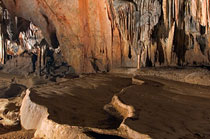 The cave is formed in the Middle Triassic pale Wetterstein limestones of the Silica Nappe along the tectonic faults by corrosive and erosive activities of Styx and Domický Brook and smaller underground tributaries draining waters mainly from the non-karst part of the basin. Horizontal oval passages with ceiling troughs dominate the cave. The passage are in places widened into domes and halls. The passage of Styx gains a character of underground canyon with meanders. Three development levels are situated in a relative lowering of 8 to 12 m. The lowest level is filled up with gravels and loam.
The cave is formed in the Middle Triassic pale Wetterstein limestones of the Silica Nappe along the tectonic faults by corrosive and erosive activities of Styx and Domický Brook and smaller underground tributaries draining waters mainly from the non-karst part of the basin. Horizontal oval passages with ceiling troughs dominate the cave. The passage are in places widened into domes and halls. The passage of Styx gains a character of underground canyon with meanders. Three development levels are situated in a relative lowering of 8 to 12 m. The lowest level is filled up with gravels and loam.
Domica Cave is connected with the Čertova diera Cave and together they reach the length of 5,368 m. They also form one genetic unit with the Baradla Cave in Hungary with the total length of about 25 km, from which almost one quarter is in the Slovak territory.
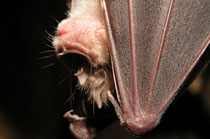 The cave is rich in sinter fills, from which the most typical are shields and drums, cascade pools (Roman Spa – Rímske kúpele, Plitvice Lakes – Plitvické jazierka), onion-like stalactites and pagoda-like stalagmites. Also other sinter forms occur in the cave. Air temperature ranges from 10.2 to 11.4°C and relative humidity from 95 to 98 %.
The cave is rich in sinter fills, from which the most typical are shields and drums, cascade pools (Roman Spa – Rímske kúpele, Plitvice Lakes – Plitvické jazierka), onion-like stalactites and pagoda-like stalagmites. Also other sinter forms occur in the cave. Air temperature ranges from 10.2 to 11.4°C and relative humidity from 95 to 98 %.
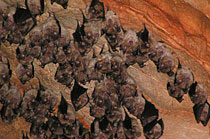 The bones of cave bear (Ursus spelaeus) were dug out from sediments in the Dry Passage. Sixteen bat species were found in the Domica Cave and Čertova diera Cave by now. The dominating one is the Mediterranean Horseshoe Bat (Rhinolophus euryale), which forms here some 1,200 – 1,400 members’ colony, the only one of such a kind in Slovakia. Thick layers of bat excrements – guano can be found in some places. Its chemical reaction with sinter created guano pots. Forty-four species of collembolans (with the most important endemite Arrhopalites slovacicus) were found in this cave together with rare palpigrade Eukoenenia spelaea, multipede of genus Typhloiulus sp., crustacean Niphargus tatrensis and many other species of terrestric and water fauna.
The bones of cave bear (Ursus spelaeus) were dug out from sediments in the Dry Passage. Sixteen bat species were found in the Domica Cave and Čertova diera Cave by now. The dominating one is the Mediterranean Horseshoe Bat (Rhinolophus euryale), which forms here some 1,200 – 1,400 members’ colony, the only one of such a kind in Slovakia. Thick layers of bat excrements – guano can be found in some places. Its chemical reaction with sinter created guano pots. Forty-four species of collembolans (with the most important endemite Arrhopalites slovacicus) were found in this cave together with rare palpigrade Eukoenenia spelaea, multipede of genus Typhloiulus sp., crustacean Niphargus tatrensis and many other species of terrestric and water fauna.
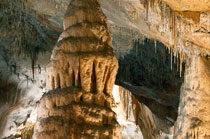 The Domica Cave had offered a short time refuge for the oldest Neolithic inhabitants of the Eastern Slovakia who were creators of the culture with the eastern linear ceramics – and its local branch so called Gemer Linear Ceramics. However, the cave had been mostly settled by the Neolithic humans of the Bukk Mountain Culture. The original entrance was later blocked by debris and the cave became inaccessible.
The Domica Cave had offered a short time refuge for the oldest Neolithic inhabitants of the Eastern Slovakia who were creators of the culture with the eastern linear ceramics – and its local branch so called Gemer Linear Ceramics. However, the cave had been mostly settled by the Neolithic humans of the Bukk Mountain Culture. The original entrance was later blocked by debris and the cave became inaccessible.
The Old Domica was known since long ago. J. Majko penetrated from its bottom through 15 m deep abyss into large underground spaces in 1926 where plenty of archaeological findings were discovered later. Post holes from dwelling objects and fireplaces were discovered in several places of the cave. More than 200 reconstructed containers from sherds as well as a terrace-dug slope in a fine-grained loam on the Styx bank with imprints of stone axes are evidences of ceramics manufacture in the cave. Irons, awls, arrows, the oldest comb in Europe, ring, decorated cylinder bracelet and fishhook represent the peak of Neolithic processing of bones. Also pendants from shells and animal teeth were preserved. Instruments from stone comprise smoothened axes, wedges and mallet with drilled hole and split stone tools – knives and scrapers. The evidence of fabrics making is the finding of a thick fabric imprint in the loam (the oldest one in Slovakia), clay whorls as well as a fragment of the conic weaving weight unit. The rear parts of the cave served probably as sacred and cult places and charcoal drawings were preserved here. Domica is one of the most important finding places of the Bukk-Mountain Culture in Slovakia.
The Club of Czechoslovak Tourists (KČST) built the lower entrance in 1930 and opened the cave for the public, including electric lighting and damming up the Styx in 1932 for the underground boat trip. At present, public has access to 1,315 m, including the 140 m long underground boat ride.
Only occassional underground water courses flow through the cave. The cave was during intensive rainfall flooded several times in the past. So the agricultural activities were guided to prevent speeding up the runoff waters and soil erosion.
The most western part of the cave system, close to the edge ponor dolines, is formed by the Čertova diera Cave. Its underground spaces descend from the opening down to the Styx riverbed. Stick stalagmites are attractive for the visitors. The easy accessible parts near the entrance of the cave are long known. L. Bartolomeides wrote about the cave in 1801. Presumed connection of the Domica Cave with the Čertova diera Cave was realized by J. Majko in 1929.
Dear visitors, we would like to inform you that due to the technical conditions of payment terminals, there may be situations when card payment will not be possible. For this reason, we recommend that you have an adequate amount of cash available if you want to be sure that you will be able to visit the cave. Thank you for understanding.